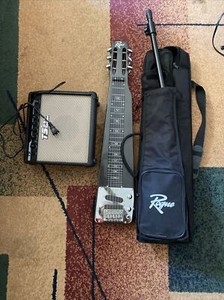Oct 09, 2020 The serial number at the back of the headstock dates it to '55. The new tuners are Gotoh relic'd units and are basically direct replacements of the old Klusons that were on it. The new pots are 500k vs the 250k and it has a good, 010 Mallory cap, now. Upside-down Oahu label!

Jun 04, 2012 The 6-digit code here is 304930. The code on the tone pot is 304931. Using the Triode Electronics EIA code list, we can suss out '304' being Stackpole, the '9' being 1949, and the '30' and '31' as weeks of the year. So the pots were made in the 30th and 31st weeks (July) of 1949. Serial number 889 stamped on the back. I haven't yet tracked down what year this was made. The little research I've done suggests that Valco didn't have an organized serial number scheme for these lap steels. Showing the odd criss-cross sunburst on the back. Cleveland Publishing Co. The word “Aloha” appears on a number of instruments and there are contradictory claims about the brand including one that states Aloha was a Hawaii-based manufacturer of guitars and amplifiers-it made a sandcast aluminum lap steel (circa late Forties-early Fifties). Valco serial numbers are listed here for reference. Valco made amplifiers with a small metal number plate on the back side up until 1964. Valco made guitars and/or amps for Supro, Dickerson, Bronson, McKinney, Sears Silvertone, Montgomery Wards (Airline), Gretsch, Oahu and many others using the same numbering system.


So I bought a cheap acoustic guitar (Harmony) and started learning songs by Woody Guthrie, Pete Seeger, early Dylan, Bias, and Collins, songs popular for our generation at that time. Then came my electric guitar years, assistant roady for a couple of our high school garage bands, from which a few would make the pro cut into the the big time, like Timothy Schmit (Eagles) and Ed Robels (Ambrosa).
Before long I was working for Carico's Edison Light Co, a subcontrator for Bill Graham, and doing psychodelic light shows for the SF Bay areas - Dead, Quicksilver, Big Brother, Airplane and the likes. In the fall of '67 and a quick hitch hike out to Greenwich Village, I found myself doing light shows for the Electric Circus, AKA the DOM/Bohemian (Andy Warhol and the Velvet Underground). I was front row for some of the biggest selling musical names of the time.
But it was not the big hip top of the bill names that left their mark, it was all those way down on the billing opening acts that impressed me the most. Names like Lighting Hopkins, Sonny Terry & Brownie McGee, Big Mamma Thorton, Bo Diddly, Mississippi, John Hurt, Blind Lemon and dozens of others. They had a different style and that different bluesy tone unlike all the big name bands and I got hooked! I wanted that blues tone sound!
Now what did my Grandfather have to do with all this?
When I couldn't duplicate that bluesy tone on my Fender amp, it was my Grandpa Ralph who pointed out that the bluesy tone was created because those small cheap tube amp circuits broke up and distorted with just a small amount of drive! I started shopping my amps from junk stores from then on. He taught me to fix about anything electronic, and later I even got the ham radio license (NO6M), sort of following in his footsteps.
But the junk store amp supply was running out and old amps seem very overpriced. so I decided to start building replicas of the best small amps of the past (now called vintage). These are the amps that Leo Fender copied for his first amps from back in 1946-47, but he wanted to change the sound (which he did) and with that change we lost a bit of important music history. (Fender focused on television for ideas while those going before him looked back at radio design for their influence).
Today when I think of vintage guitar amps, I don't think of late 1950's and 60's Fenders, I think about the amplifiers of my Grandfather's generation and how they influenced Leo Fender way back in the 40's. Vintage to me is not another copy of an old Fender amp, the world has quite enough of those. Vintage to me is all the non Fender amps circa 1947.
My goal is to preserve a bit of that 40's and early 50's era blues tone look and feel, paying attention to the pre 60's non Fender vintage tube circuits and cabinet designs! To make it affordable and fun. My simple reproduction Valco amp/cab combos meet those goals!

Oahu Lap Steel For Sale
Sincerely, David Barnes (NO6M)